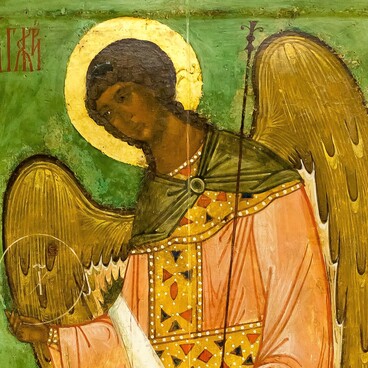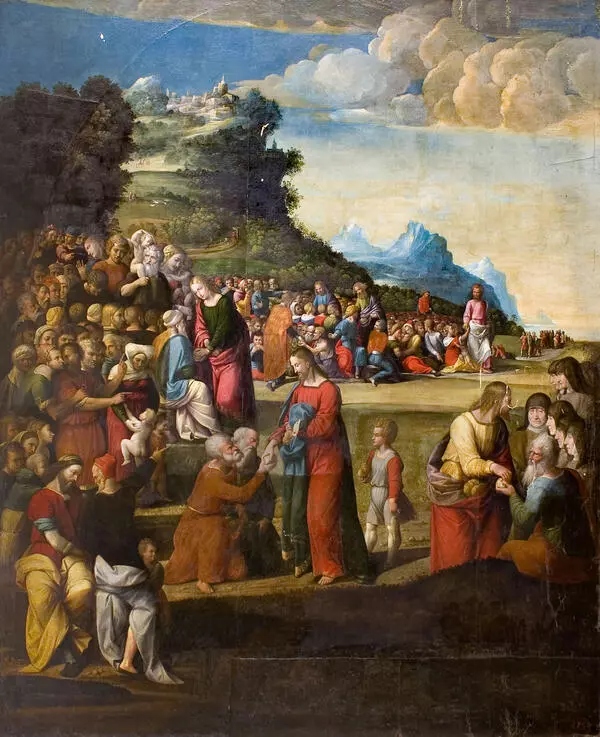‘Annunciation’ was painted by an Italian artist Benvenuto Tisi. The painting belongs to the Renaissance, it was created around the end of the 15th — first half of the 16th century. The painter depicted the scene of the Annunciation described in the Gospel of Luke: the archangel Gabriel appeared to the Virgin Mary and told her that she would become the mother of Christ.
This subject was addressed by many Renaissance artists — Leonardo da Vinci, Sandro Botticelli, Filippino Lippi. By that time, certain traditions had developed in the depiction of characters: Mary was more often placed on the right side of the painting, and the archangel was painted on the left. Artists portrayed the Mother of God in red and blue robes: while red represented her human nature, blue spoke of divine holiness. In his hand, the archangel often held lilies — a symbol of purity.
For this painting, Tisi went against several of those traditions: he moved the Virgin Mary to the left, the Archangel Gabriel — to the right. He also painted Mary in blue and white robes only.
Another interesting peculiarity about the painting is that the artist paid little to no attention to the surrounding environment. He focused on the characters themselves and created volumes with light and shadow, depicted authentic-looking hands, feet and folds on fabrics. At the same time, the painter slightly lengthened the proportions of the bodies and put the models in unnatural, ‘ceremonious’ poses with the archangel impulsively crossing his arms across his chest and the Virgin Mary gracefully raising her wrist.
Pursuance of special elegance, zigzag lines and tense poses are all reminiscent of Mannerism — the late stage of the Renaissance when a decline in art followed a period of extensive development. The painter’s focus on detail rather than on the integrity of the composition is also characteristic of Mannerism.
Benvenuto Tisi lived from 1481 to 1559. The artist is more often mentioned under the pseudonym Garofalo: according to one version, Tisi’s nickname derived from the place of Garofalo in the province of Rovigo, the birthplace of his father; according to the other version the artist received his byname because of the carnation image on his coat-of-arms. In Italian, ‘carnation’ is spelled ‘garofano’, which sounds similar to the pseudonym Garofalo. It is known that the artist signed many of his paintings with a small image of a carnation.
At various times Garofalo worked in Rome, Bologna, Ferrara, as well as at the court of the dukes d’Este. He created paintings and frescoes mainly on religious, allegorical and mythological subjects. A famous Renaissance master Giorgio Vasari wrote about him:
This subject was addressed by many Renaissance artists — Leonardo da Vinci, Sandro Botticelli, Filippino Lippi. By that time, certain traditions had developed in the depiction of characters: Mary was more often placed on the right side of the painting, and the archangel was painted on the left. Artists portrayed the Mother of God in red and blue robes: while red represented her human nature, blue spoke of divine holiness. In his hand, the archangel often held lilies — a symbol of purity.
For this painting, Tisi went against several of those traditions: he moved the Virgin Mary to the left, the Archangel Gabriel — to the right. He also painted Mary in blue and white robes only.
Another interesting peculiarity about the painting is that the artist paid little to no attention to the surrounding environment. He focused on the characters themselves and created volumes with light and shadow, depicted authentic-looking hands, feet and folds on fabrics. At the same time, the painter slightly lengthened the proportions of the bodies and put the models in unnatural, ‘ceremonious’ poses with the archangel impulsively crossing his arms across his chest and the Virgin Mary gracefully raising her wrist.
Pursuance of special elegance, zigzag lines and tense poses are all reminiscent of Mannerism — the late stage of the Renaissance when a decline in art followed a period of extensive development. The painter’s focus on detail rather than on the integrity of the composition is also characteristic of Mannerism.
Benvenuto Tisi lived from 1481 to 1559. The artist is more often mentioned under the pseudonym Garofalo: according to one version, Tisi’s nickname derived from the place of Garofalo in the province of Rovigo, the birthplace of his father; according to the other version the artist received his byname because of the carnation image on his coat-of-arms. In Italian, ‘carnation’ is spelled ‘garofano’, which sounds similar to the pseudonym Garofalo. It is known that the artist signed many of his paintings with a small image of a carnation.
At various times Garofalo worked in Rome, Bologna, Ferrara, as well as at the court of the dukes d’Este. He created paintings and frescoes mainly on religious, allegorical and mythological subjects. A famous Renaissance master Giorgio Vasari wrote about him:




